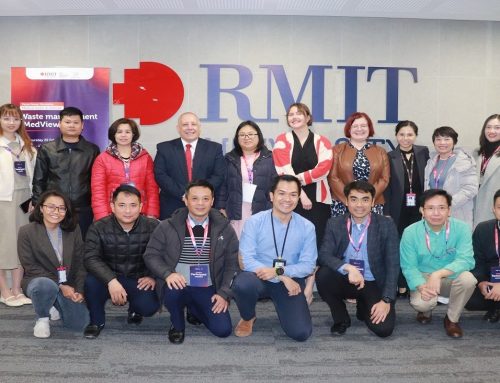We have once again got the pleasure of having a guest writer here on our blog. This time it is Cécile L’Hermitte with her article Developing organisational capabilities to support agility in humanitarian logistics: An exploratory study that appeared in the latest issue of the Journal of Humanitarian Logistics and Supply Chain Management. (link to the journal here)
The following discussion relates to a 3-year research project conducted with the help of the logistics staff of the World Food Programme and of Mike Whiting from the Forum for Humanitarian and Emergency Logistics Professionals (HELP) of the Chartered Institute of Logistics and Transport in the United Kingdom (CILT UK)
Since change, uncertainty and disruptions are routinely encountered in disaster relief operations and in longer-term recovery and development programmes, humanitarian organisations need to build and maintain a high level of agility, i.e. they need to be able to respond swiftly to sudden and short-term field-level turbulence and to rapidly adapt their logistics and supply chain operations in order to overcome/mitigate the emerging challenges. To date, researchers and practitioners have primarily associated agility with tactical considerations such as the ability to preposition supplies in preparation for coming emergencies, to mobilise and deploy resources within hours of a disaster occurrence, to rapidly reconfigure transport operations, or to find creative solutions to fix immediate problems in the field. Although these operational elements are crucial agility factors, being truly agile goes beyond functional skills and expertise. It also comes from the organisation’s own systems, structure and culture and should, therefore, be built into the organisation itself.
In particular, conducting agile logistics operations depends on the development of 4 higher level capabilities, i.e. being purposeful, action-focused, collaborative, and learning-oriented:
- Being purposeful is the ability of an organisation to maintain a clear direction for humanitarian action. It enhances agility because a clear and strong organisational purpose serves as an anchor point in turbulent and constantly changing environments, and contributes to steering individuals, teams and the whole organisational system when they are exposed to unexpected and disrupting circumstances. Thus, a clear and widely understood purpose assists people and teams in setting the right priorities and, ultimately, in acting confidently and competently in stressful and ambiguous field situations.
- Being action-focused is the ability to build readiness and marshal the organisation to respond to the risks and uncertainties encountered along the humanitarian supply chains. It is about providing field logisticians with appropriate tools that enable them to manage contingencies in a swift and effective manner. These tools include, for example, standardised processes and procedures that enable field workers to manage common operational situations, short and rapid decision making lines to deal swiftly with exceptional circumstances, and the use of information technology to make timely and accurate information available.
- Being collaborative is the ability to build and sustain relationships within and outside the humanitarian organisation in order to solve problems collaboratively. Well-developed relationships are essential to agility building because they enable people and organisations to deal with problems that go beyond their own ability to solve. In other words, agility cannot be built by a single person or a single organisation but, rather, stems from people and organisations calling on each other.
- Being learning-oriented is the ability to identify and capture past field experiences, to share them across operations, and to turn them into improved practices. It prevents field workers from ‘reinventing the wheel’ and enables them to make faster and better decisions. In addition, learning from past experiences supports agility because past ways of operating may no longer be appropriate and/or efficient/effective enough. Thus, an organisation should continuously look for new solutions, create and transfer knowledge, and modify its plans and ways of working accordingly.
These 4 capabilities show that building agility transcends the operational/functional level of a humanitarian organisation, i.e. it goes beyond logistics expertise (for example in warehousing, shipping, or fleet management) and stems from a number of higher level organisational mechanisms. Developing these mechanisms and ensuring that agility is deeply embedded in the way the organisation operates requires a clear commitment and inputs from all leadership and management levels within the organisation. In other words, the leaders and managers of humanitarian organisations are responsible for building an agile system and culture, and to move the concept of agility from ad hoc and creative problem solving at the functional/operational level to the longer-term building and internationalisation of an adaptive capacity at the organisational level. By doing so, they will not only ensure that field workers are better tooled to respond to the multiple complexities and dynamics existing in the field, but also support more structured and lasting capacity building that will enable the organisation to shift more easily from one operational environment to another.
The research was underpinned by a questionnaire designed to collect data on a set of 40 key practices that support the development of the 4 above-mentioned capabilities. This questionnaire, which can be used as an assessment tool to evaluate an organisation’s current organisational practices and to rapidly identify areas of excellence and areas of improvement, is available from Cécile.
– Cécile & Peter
Link to the article on Journal of Humanitarian Logistics and Supply Chain Management here
- Cécile L’Hermitte , Peter Tatham , Marcus Bowles , Ben Brooks , (2016) “Developing organisational capabilities to support agility in humanitarian logistics: An exploratory study”, Journal of Humanitarian Logistics and Supply Chain Management, Vol. 6 Iss: 1, pp.72 – 99




